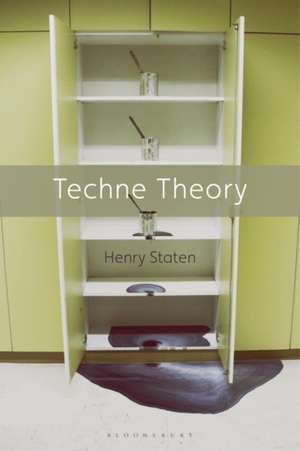Techne Theory: A New Language for Art
Autor Henry Statenen Limba Engleză Paperback – 20 feb 2019
| Toate formatele și edițiile | Preț | Express |
|---|---|---|
| Paperback (1) | 165.48 lei 22-36 zile | +40.68 lei 5-11 zile |
| Bloomsbury Publishing – 20 feb 2019 | 165.48 lei 22-36 zile | +40.68 lei 5-11 zile |
| Hardback (1) | 497.56 lei 43-57 zile | |
| Bloomsbury Publishing – 20 feb 2019 | 497.56 lei 43-57 zile |
Preț: 165.48 lei
Preț vechi: 192.18 lei
-14% Nou
Puncte Express: 248
Preț estimativ în valută:
31.66€ • 33.15$ • 26.20£
31.66€ • 33.15$ • 26.20£
Carte disponibilă
Livrare economică 17-31 martie
Livrare express 28 februarie-06 martie pentru 50.67 lei
Preluare comenzi: 021 569.72.76
Specificații
ISBN-13: 9781472592903
ISBN-10: 1472592905
Pagini: 216
Dimensiuni: 156 x 234 x 15 mm
Greutate: 0.32 kg
Editura: Bloomsbury Publishing
Colecția Bloomsbury Academic
Locul publicării:London, United Kingdom
ISBN-10: 1472592905
Pagini: 216
Dimensiuni: 156 x 234 x 15 mm
Greutate: 0.32 kg
Editura: Bloomsbury Publishing
Colecția Bloomsbury Academic
Locul publicării:London, United Kingdom
Caracteristici
Original claim and theory centered around the deployment of the concept of techne, which is both explored philosophically and utilized as the basis for a mode of adoptable critical practice
Notă biografică
Henry Staten is Byron W. and Alice L. Lockwood Professor in the Humanities, University of Washington, USA. His acclaimed first book, Wittgenstein and Derrida (1984) was one of the first philosophical commentaries on deconstruction. Since then his work has ranged widely across literature and philosophy from the Greeks through modernism.
Cuprins
AcknowledgementsPart One: FundamentalsChapter 1: Introduction: The Techne Standpoint Chapter 2: Art and Evolution Chapter 3: The Artist's Touch Part Two: Origins in Greek PhilosophyChapter 4: How Plato (Despite Himself) Invented Techne Theory Chapter 5: From Aristotle to Extended Mind Part Three: Where Do Poems Come From?Chapter 6: A Romantic View: Seamus Heaney Chapter 7: Excursus on the Nature of Language Chapter 8: An Anti-Romantic View: Paul Valéry Part Four: Studies in Modernist TechneChapter 9: T. J. Clark's Picasso Chapter 10: What's Radical About Radical Painting? Chapter 11: The Techne of Kafka's Metamorphosis Part Five: Techne MetatheoryChapter 12: Universal Design Space and the Lines of Force Bibliography Index
Recenzii
Each of the diverse chapters makes for highly interesting (and for an analytic philosopher refreshingly different) reading . [For] analytic philosophers of aesthetics, who have for the most part neglected the topic of creativity, this book is interesting and creative in both style and content.
From the standpoint of techne theory, Kant's most radical insight concerned the limitation of the creative power of individual genius, which cannot account for the emergence of the novelty or the formal evolution of the artwork. Building on this critical insight, Staten creates a highly original phenomenological investigation into the technical components of "art-making," remaining grounded in material processes and what art and literary theory can (and cannot) tell us about them.
In this learned, original, important, and always lively new study, Henry Staten moves today's heated and often sterile debate about aesthetic form to a new place-a place that is also (and in the best sense), an old place, newly inhabited. Staten rethinks Plato's and Aristotle's concepts of eidos and techne in three ways: first, by bringing searching attention of a scholarly and critical kind to tensions and contradictions within the founding works themselves; second, by making those works respond to the very developments that they sponsored in both Romantic and modernist works; and third, by coordinating ancient Greek concepts of art, form, medium, making, and doing, with a posthumanist framework that reunites knowledge and know-how, theory and practice, eidos and hyle, and vates and poietes. Anyone with any interest in the idea of form (and in the formation of ideas) should read this book. It changes the game we've been playing.
From the standpoint of techne theory, Kant's most radical insight concerned the limitation of the creative power of individual genius, which cannot account for the emergence of the novelty or the formal evolution of the artwork. Building on this critical insight, Staten creates a highly original phenomenological investigation into the technical components of "art-making," remaining grounded in material processes and what art and literary theory can (and cannot) tell us about them.
In this learned, original, important, and always lively new study, Henry Staten moves today's heated and often sterile debate about aesthetic form to a new place-a place that is also (and in the best sense), an old place, newly inhabited. Staten rethinks Plato's and Aristotle's concepts of eidos and techne in three ways: first, by bringing searching attention of a scholarly and critical kind to tensions and contradictions within the founding works themselves; second, by making those works respond to the very developments that they sponsored in both Romantic and modernist works; and third, by coordinating ancient Greek concepts of art, form, medium, making, and doing, with a posthumanist framework that reunites knowledge and know-how, theory and practice, eidos and hyle, and vates and poietes. Anyone with any interest in the idea of form (and in the formation of ideas) should read this book. It changes the game we've been playing.
